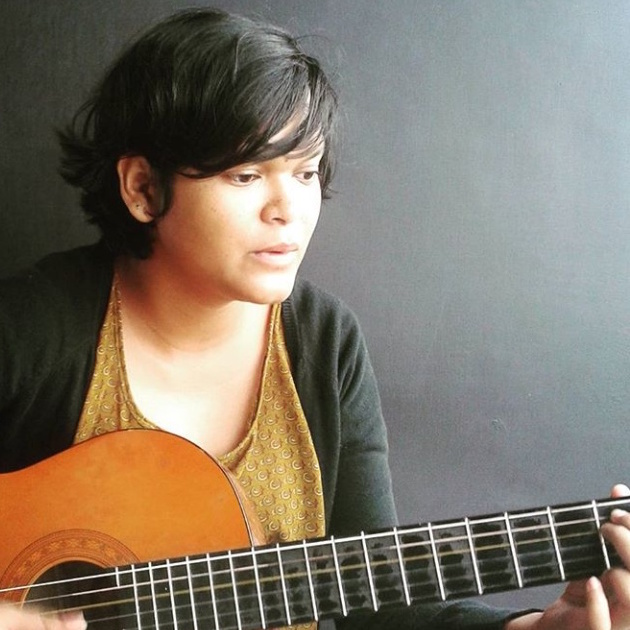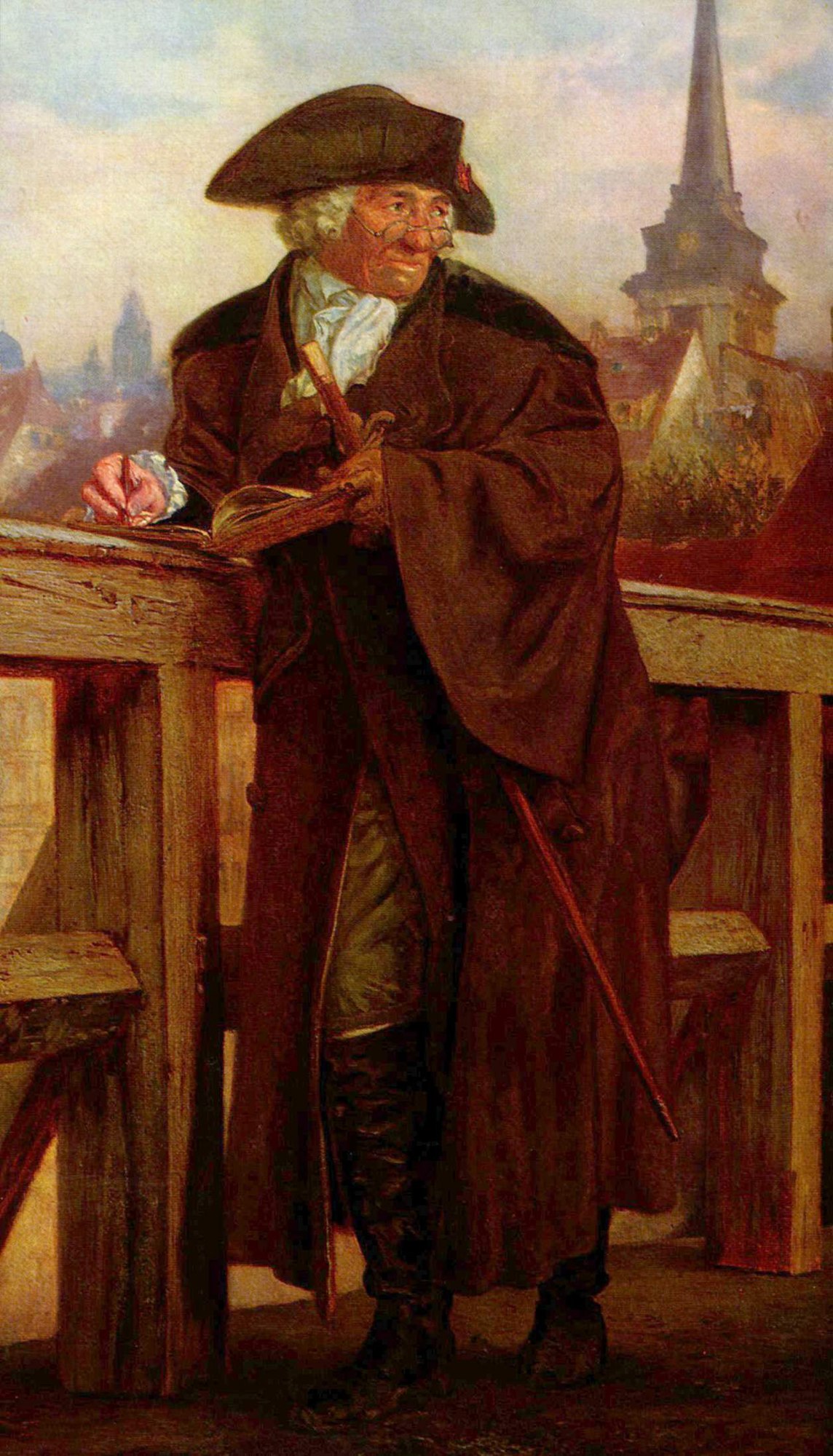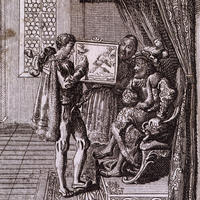More about Daniel Nikolaus Chodowiecki
Works by Daniel Nikolaus Chodowiecki

Contributor
Daniel Nikolaus Chodowiecki hated it when people called him the Berlin Hogarth.
He didn’t hate the original Hogarth, he just resented the implications. Sure, Chodowiecki lived in Berlin and made humorous etchings of daily life (much like Hogarth), but that doesn’t mean he was trying to be like Hogarth. Give the guy a break, he was 18th century Germany’s most illustrious graphic artist. He deserves some credit.
Chodowiecki was born in Danzig in 1726. His dad was a corn merchant, and his mother was a refugee, a Huegenot. The Huguenots were subjected to severe oppression by the Catholic government of France in the 16th and 17th-century. A few of them fled to Danzig where they set up their own Church. His parents joined the reformed church after their marriage and raised him according to this faith. Chodowiecki would go for both masses on Sunday and take notes of the sermon. He’d go home and set up debates with his family, based on what he had heard. What a serious kid! Go out and play a little.
Mr. Chodowiecki died when he was around 16 or 17 years old. He had taught Daniel the art of miniature painting and had always supported his art. Losing such an awesome father must have been hard for him. He left for Berlin right after to help his uncle with his shop there, but he had other plans. Though largely a self-taught artist, he did receive help from Johann Jacob Haid, a copper engraver, who taught him enamel painting in 1748.
Chodowiecki tried his hand at painting, but soon realized that he was way better at etching. He became celebrated for his dexterity with both engravings and etchings. Through the years that he was active, Chodowiecki made about 2000 etched copper plates. Everybody wanted a piece of the Chodo. He illustrated pocket calendars, educational books by Johann Bernhard Basedow, physiology books by Lavater, plays of Shakespeare, historical accounts, and a lot more. He was the biggest fish in Germany’s pond. Back then, that was enough. It made him Director of the Berlin Academy of Art in 1797.
Chodowiecki spent most of his life in Berlin. He would often try to untangle his identity to know if he was French, Polish, or German. He cohabitated with French people, he worked and lived in a German town, but he never got to understand his Polish ancestry. In 1773, he decided to explore it. He had not seen his mother and sisters for 30 years. It had been a long time since he had been back in his hometown. He got himself a horse instead of a stage coach to make the journey home. Chodowiecki published Journey from Berlin to Danzig the same year. It was full of illustrations about his travels and his homeland.
Daniel Nikolaus Chodowiecki died in 1801 and is buried at Französischer Friedhof cemetery in Berlin.
Disclaimer: Some of the links are amazon affiliate links, meaning that at no additional cost to you, by clicking through and making a purchase, you will also be contributing to the growth of Sartle.
Sources
- C., A. "DANIEL NICHOLAS CHODOWIECKI." The Mask, July 1928, 134.
- "Daniel Chodowiecki - The Polonica." Porta Polonica. Accessed August 01, 2019. https://www.porta-polonica.de/en/atlas-of-remembrance-places/daniel-cho….
- "Nicholas Daniel Chodowiecki." Start - Deutsches Hugenotten-Museum Bad Karlshafen. Accessed August 01, 2019. http://www.huguenot-museum-germany.com/huguenots/chodowiecki.php.
- Britannica, The Editors of Encyclopaedia. "Daniel Chodowiecki." Encyclopædia Britannica. Accessed August 01, 2019. https://www.britannica.com/biography/Chodowiecki-Daniel.
- Greenberg, Morris. "DANIEL CHODOWIECKI, EIGHTEENTH CENTURY ETCHER." The Brooklyn Museum Quarterly 8, no. 4 (1921): 121-31. http://www.jstor.org/stable/26459331.
- He, Andy. "Daniel Chodowiecki." Daniel Chodowiecki. Accessed August 01, 2019. http://hisour.blogspot.com/2017/05/daniel-chodowiecki.html.
Featured Content
Here is what Wikipedia says about Daniel Chodowiecki

Daniel Niklaus Chodowiecki (16 October 1726 – 7 February 1801) was a German painter and printmaker of Huguenot and Polish ancestry, who is most famous as an etcher. He spent most of his life in Berlin, and became the director of the Berlin Academy of Art.
Family
He was born in the city of Danzig (Gdańsk) in Poland, he kept close to the Huguenot scene, due to his ancestry.
According to Chodowiecki himself, his Polish nobleman paternal ancestor Bartłomiej Chodowiecki lived in the 16th century in Greater Poland, though this is not confirmed by independent records. Gottfried Chodowiecki, Daniel's father, was a tradesman in Danzig and his mother, Henriette Ayrer, of Swiss ancestry, was a Huguenot. Daniel's grandfather Christian was also a Danzig tradesman, who had moved his business there from Toruń. When his father died, both Daniel (aged 16) and his younger brother Gottfried Chodowiecki went to live with their uncle in Berlin, who offered to educate them. In Germany Daniel received artistic training from the painter Haid in Augsburg. His brother also became a painter.
He and his wife Jeanne Barez (1726–1785) had three daughters, Jeannette (b. 1761, married the French reformed preacher Jacques Papin), Suzanne (1763–1819) and Henriette (1770–1880). Jeannette's daughter Marianne Gretschel née Chodowiecka Papin (1794–1870) and her son Heinrich Papin (1786–1839) also became artists.
Check out the full Wikipedia article about Daniel Chodowiecki











